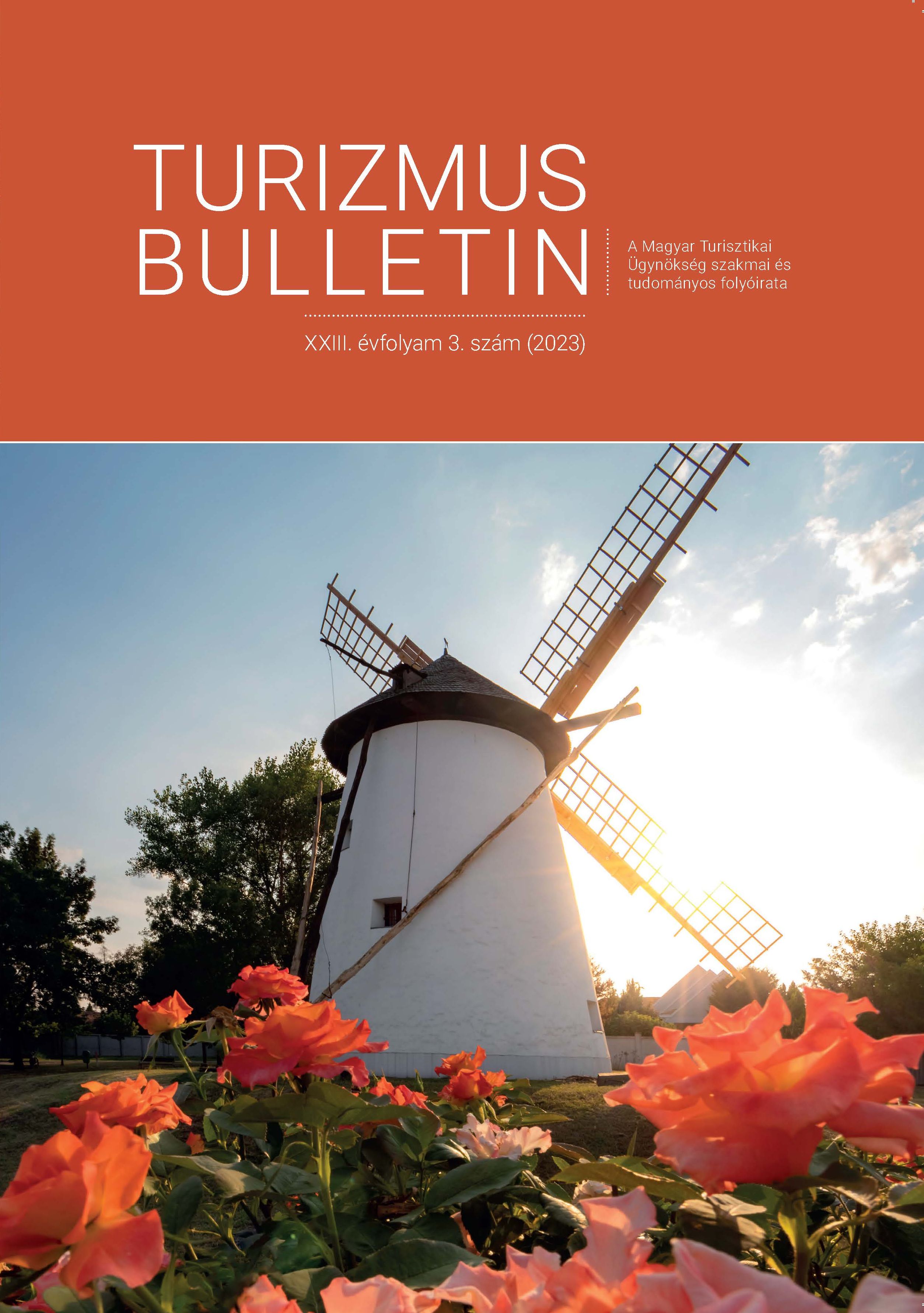Tourism destination design along the Danube
DOI:
https://doi.org/10.14267/TURBULL.2023v23n3.4Keywords:
destination, design, networking, multimodality, Lower-IpolymenteAbstract
The article presents a Hungarian design-based best practice, which will enable the implementation of a Danube micro-destination, specifically the tourism developments along the Lower-Ipoly and the Lower-Garam. This would be in a coordinated network, based on multimodality, exploiting mutual synergies, both on the Hungarian and the Slovakian sides. In order to achieve this, the “Hungary NEXT” country-brand workshop, in the framework of a European Union Interreg project, with the Pontibus Limited Liability European Territorial Partnership as the lead partner, organised focus group workshops. The aim was to develop project packages that form the basis of a cross-border destination based on a single offer. The Pontibus Limited Liability European Territorial Partnership was established in 2015 by the Municipality of Pest County and the District Municipality of Nitra with the aim of developing social, economic, touristic, cultural and inter-institutional relations in the cross-border area, thus contributing to the coordinated development of the region.
References
BASSA, L. – BÓDIS, G. (2023): How to Establish Appropriate Tourism after 2020? In: Toro, A. – Duda, T. – Schmude, J. (eds): Tourism Recovery from COVID-19 – Prospects for Over- and Undertourism Regions. Managing Cultural Tourism. A Sustainability approach. World Scientific Publications Ltd. (2)7, pp. 94–95.
BEDŐCS B. – KOVÁCS N. (2022): Turisztikai Akcióterv, Helyzetfeltáró vizsgálat eredményei. Projektzáró prezentáció, Ipolyszalállos. 2022. szeptember 28.
BERENCSI M. (2022): A kerékpáros turizmus trendjei és hazai fejlesztési lehetőségei. In: Jászberényi M. – Boros K. – Miskolczi M. (szerk): Vonzerőfejlesztés a kulturális és aktív turizmusban. Turizmus és Mobilitás sorozat. Akadémiai Kiadó, Budapest.
BÓDIS G. (2019): Kalandturizmus. In: Irimiás A. – Jászberényi M. – Michalkó G. (szerk): Turisztikai termékek innovatív fejlesztése. Akadémiai Kiadó, Budapest.
BROZZI, R. – RAUCH, E. – RIEDL, M. – MATT, D. T. (2021): Industry 4.0 roadmap for SMEs: validation of modetation techniques for creativity workshops. International Journal of Agile Systems and Management. 14(2). pp. 276–291. HTTPS://DOI.ORG/10.1504/ IJASM.2021.118064
CSAPÓ J.–MATESZ K. (2007): A kulturális turizmus jelentősége és szerepe napjaink idegenforgalmában. Földrajzi Értesítő. 56(3–4). pp. 291–301.
FETTERMAN, A. K. – ROBINSON, M. D. – MEIER, B. P. (2012): Anger as “Seeing red”: Evidence for a perceptual association. Cognition & Emotion. 26(8). pp. 1445–1458. https://doi.org/10.1080/02 699931.2012.673477
HUNGARY NEXT (2018): SO PR ON: Látogatói attitűdök és integrált fejlesztési lehetőségek. Sopron újramárkázása workshop sorozat. Hungary NEXT ország-márka-műhely. Hotel Sopron, Sopron; Hotel Viktória, Budapest; Café Altes Backhaus, Eisenstadt. 2018. június 5., 11., július 16.
JÁSZBERÉNYI M. – PÁLFALVI J. (2006): Közlekedés a gazdaságban: Közlekedés-gazdasági aspektusok. Aula Kiadó, Budapest.
KÁDÁR B. – GEDE M. (2020): Egynapos desztinációk követése a közösségi médiában közvetített fényképeken keresztül – a Balaton-felvidék és a Dunakanyar elemzése és összehasonlítása. Turizmus Bulletin. 20. Különszám. pp. 31–32. https://doi.org/10.14267/ TURBULL.2020v20n4.3
KONDOR A. CS. – SZABÓ T. – PROROK M. (2020): Az egynapos látogatóforgalom elemzése mobilcella adatok alapján Szentendre példáján. Turizmus Bulletin. 20. Különszám. pp. 19–28. https://doi.org/10.14267/ TURBULL.2020v20n4.2
KOVÁCS A. (2022): A vízi turizmus vonzerejének fejlesztése itthon és a nagyvilágban. In: Jászberényi M. – Boros K. – Miskolczi M. (szerk): Vonzerőfejlesztés a kulturális és aktív turizmusban. Turizmus és Mobilitás sorozat. Akadémiai Kiadó, Budapest. pp. 229–230.
LÓSKA J. (2022): A lovasturizmus újrapozícionálása a 21. századi igényekhez igazodva. In: Jászberényi M. – Boros K. – Miskolczi M. (szerk.): Vonzerőfejlesztés a kulturális és aktív turizmusban. Turizmus és Mobilitás sorozat. Akadémiai Kiadó, Budapest.
MASLOW, A. (2003): A lét pszichológiája felé. Ursus Libris, Budapest.
MICHALKÓ G. (2012): Turizmológia – Elméleti alapok. Akadémiai Kiadó, Budapest.
MISKOLCZI, M. – JÁSZBERÉNYI, M. – MUNKÁCSY, A. – NAGY, D. (2020): Accessibility of major Central and Eastern European cities in Danube cruise tourism. Deturope. 12(3). 133–150.
MOLNÁR A. J. (2022): A gyalogos aktív turisztikai útvonalak fejlesztési szempontjai a jó gyakorlatok fényében. In: Jászberényi M. – Boros K. – Miskolczi M. (szerk.): Vonzerőfejlesztés a kulturális és aktív turizmusban. Turizmus és Mobilitás sorozat. Akadémiai Kiadó, Budapest.
MTÜ (2017): Nemzeti Turizmusfejlesztési Stratégia 2030. Aktív és természeti turizmus. Magyar Turisztikai Ügynökség, Budapest. pp. 55–56.
PRINCZ-JAKOVICS T. – VASVÁRI G. (2018): A hazai kisvasutak forgalmának turisztikai potenciál alapú vizsgálata. Turizmus Bulletin. (18)3. pp. 15–22. https://doi.org/10.14267/ TURBULL.2018v18n3.2
PUCZKÓ L.–RÁTZ T. (1998): A turizmus hatásai. Aula Kiadó, Budapest. Internetes források
MAKASE (2023): Ipoly erdő két keréken és vízen – Vadregényes hosszú-hétvégi kalandtúra a Börzsönyben. https://www.kaland.sport. hu/celpontjaink/magyarorszag/ipolyerdo-ket-kereken-es-vizen-a-vadregenyesboerzsoenyben Letöltve: 2023. május 22.
PONTIBUS (2022): Turisztikai akcióterv megalapozása és tervezése az Alsó-Ipoly mentén. http://www. pontibusegtc.eu/index.php/hu/component/ content/article/8-aktualis-informaciok/157- tourismdesign?Itemid=142 Letöltve: 2022. május 20.
SAMPSON, J. (2022): Collaboration can help us confront tourism’s greatest challenges ahead. https://www. citynationplace.com/collaboration-can-help-usconfront-tourisms-greatest-challenges-ahead Letöltve: 2023. május 20.
XELLUM (2021): Szentendre Város Turisztikai Koncepció-terve. 2021.04.28. Szentendre Város Önkormányzata, Xellum Kft. pp. 51–52. https:// szentendre.hu/wp-content/uploads/2021/05/ SZENTENDRE-TURISZTIKAI-KONCEPCIO_ melleklettel-210428.pdf Letöltve: 2022. május 20.

